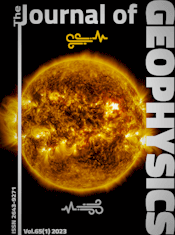Rheological properties and velocity dispersion of a medium with power-law dependence of Q on frequency
Article Sidebar

Vols. 1-18 (1924-1944), ISSN 0044-2801
Main Article Content
Abstract
The Kramers-Kronig relations for magnitude and phase of a linear causal filter are used to derive an exact general expression for the viscoelastic modulus M, corresponding to power laws for the quality factor, Q ≈ ωγ. The exponent γ varies from -1 to + 1, such that the spectrum of rheologies extends from a Kelvin-Voigt to a Maxwell body. High- and low-frequency approximations for M(ω) are derived, and in the special cases γ = ±1, ±1/2, ±1/3, ±1/4,... closed-form solutions are given which apply for arbitrary frequencies. With M(ω) at hand, both high-frequency phenomena such as velocity dispersion and low-frequency phenomena such as creep and stress relaxation can be investigated. Results for phase-velocity dispersion are given as well as short- and long-time-scale approximations of the creep and relaxation functions. Simple dissipation operators are derived which can be convolved with theoretical seismograms in order to correct these for the influence of absorption. Some results on relaxation spectra for the case 0 ≤ γ ≤ 1 are summarized in an appendix. Taken together, the results of this paper suggest that media with 0 < γ < 1 should be considered as generalized Maxwell bodies and media with -1 < γ < 0 as generalized Kelvin-Voigt bodies. Application of the Kramers-Kronig relations to the viscoelastic modulus is better than the use of those relations in conjunction with the wavenumber of a plane wave, which is the procedure that has been employed so far.
 ARK: https://n2t.net/ark:/88439/y076559
ARK: https://n2t.net/ark:/88439/y076559
Permalink: https://geophysicsjournal.com/article/82
Article Details
References
Berckhemer, H., Kampfmann, W., Aulbach, E., Schmeling, H. (1982) Shear modulus and Q of forsterite and dunite near partial melting from forced-oscillation experiments. Phys. Earth Planet. Inter. 29:30-41
Brennan, B.J. (1980) Pulse propagation in media with frequencydependent Q. Geophys. Res. Lett. 7:211-213
Brennan, BJ., Smylie, D.E. (1981) Linear viscoelasticity and dispersion in seismic wave propagation. Rev. Geophys. Space Phys. 19:233-246
Cathles, L.M. (1975) The viscosity of the earth's mantle. Princeton University Press, Princeton, N.J.
Chin, R.C.Y. (1980) Wave propagation in viscoelastic media. In: Dziewonski, A., Boschi, E. (eds.) Physics of the earth's interior, Proceedings of Enrico Fermi International School of Physics, pp. 213-246. North-Holland, Amsterdam
Frasier, C.W., Filson, J. (1972) A direct measurement of the earth's short-period attenuation along a teleseismic ray path. J. Geophys. Res. 77:3782-3787
Gross, B. (1947) On creep and relaxation. J. Appl. Phys. 18:212-221
Jordan, T.H., Sipkin, S.A. (1977) Estimation of the attenuation operator for multiple ScS waves. Geophys. Res. Lett. 4:167-170
Kjartansson, E. (1979) Constant Q wave propagation and attenuation. J. Geophys. Res. 84:4737-4748
Lundquist, G.M., Cormier, V. F. (1980) Constraints on the absorption band model of Q. J. Geophys. Res. 85:5244-5256
Lambeck, K. (1980) The earth's variable rotation: geophysical causes and consequences. New York: Cambridge University Press
MacDonald, J.R., Brachman, M.K. (1956) Linear-system integral transform relations. Rev. Mod. Phys. 28:393-422
Minster, J.B. (1980) Anelasticity and attenuation. In: Dziewonski, A., Boschi, E. (eds.) Physics of the earth's interior, Proceedings of Enrico Fermi International School of Physics, pp. 152-212. North-Holland, Amsterdam
Millier, G., Schott, W. (1981) Some recent extensions of the reflectivity method. In: Identification of seismic sources - earthquake of underground explosion. E.S. Husebye, S. Mykkeltveit, eds.: pp. 347-371. D. Reidel Publ. Comp., Dordrecht
Okubo, S. (1982) Theoretical and observed Q of the Chandler wobble - Love number approach. Geophys. J. R. Astron. Soc. 71:647-657
Peltier, W.R. (1976) Glacial isostatic adjustments - II. The inverse problem. Geophys. J. R. Astron. Soc. 46:669-709
Peltier, W.R. (1980) Mantle convection and viscosity. In: Dziewonski, A., Boschi, E. (eds.) Physics of the earth's interior, Proceedings of Enrico Fermi International School of Physics, pp. 362-431. North-Holland, Amsterdam
Peltier, W.R., Wu, P., Yuen, D.A. (1981) The viscosities of the earth's mantle. In: Stacey, F.D., Paterson, M.S., Nicholas, A. (eds.) Anelasticity in the earth, Geodynamics Series, vol. 4, pp. 59-77. Washington, D.C.: American Geophysical Union
Sipkin, S.A., Jordan, T. (1979) Frequency dependence of Qscs. Bull. Seismol. Soc. Am. 69:1055-1079
Smith, M.L., Dahlen, F.A. (1981) The period and Q of the Chandler wobble. Geophys. J. R. Astron. Soc. 64:223-281
Stacey, F.D., Paterson, M.S., Nicholas, A. (eds.) (1981) Anelasticity in the earth. Geodynamics Series, vol. 4, 122 p. American Geophysical Union, Washington, D.C.
Strick, E. (1967) The determination of Q, dynamic viscosity and transient creep curves from wave propagation measurements. Geophys. J. R. Astron. Soc. 13:197-208











